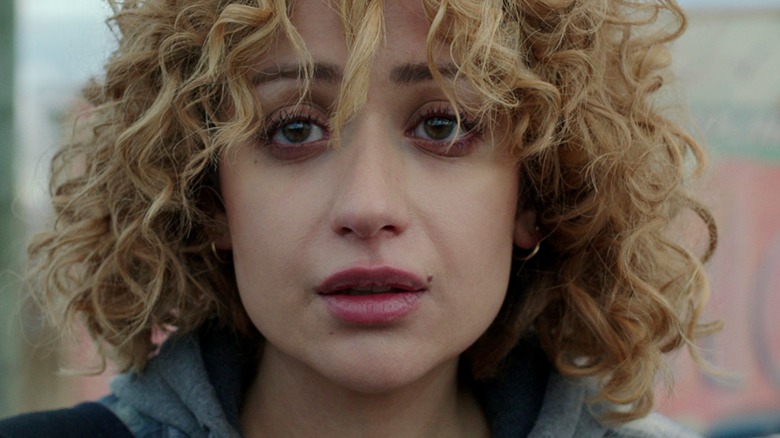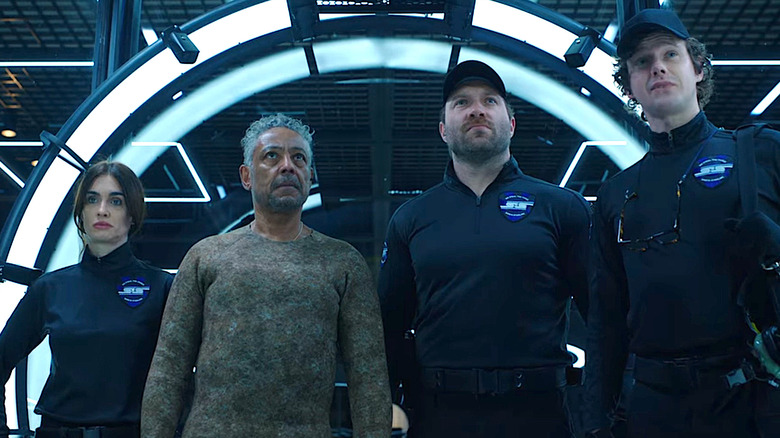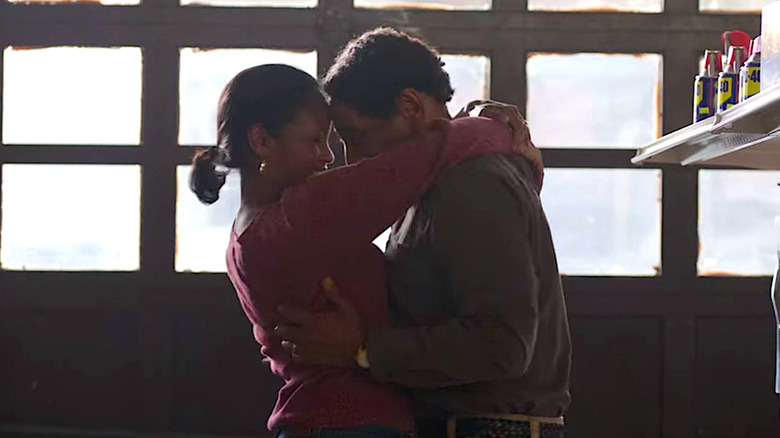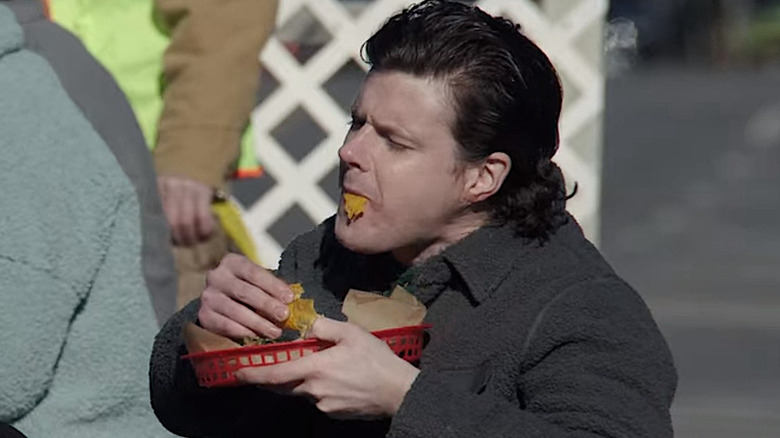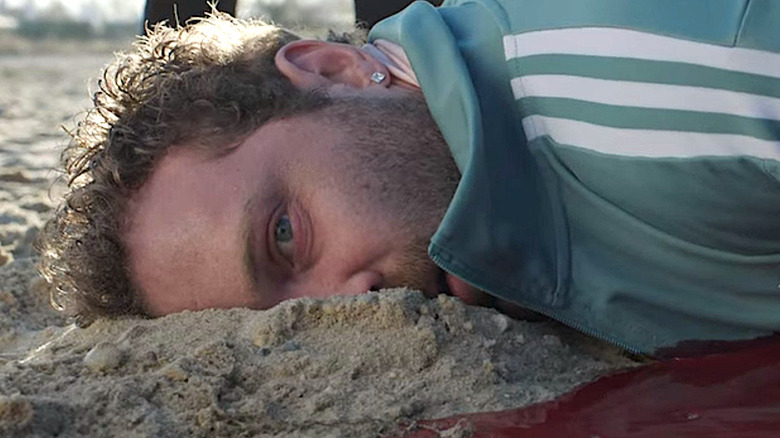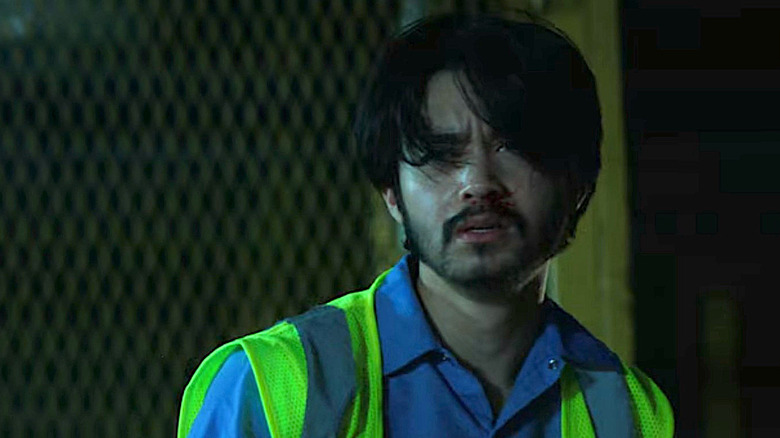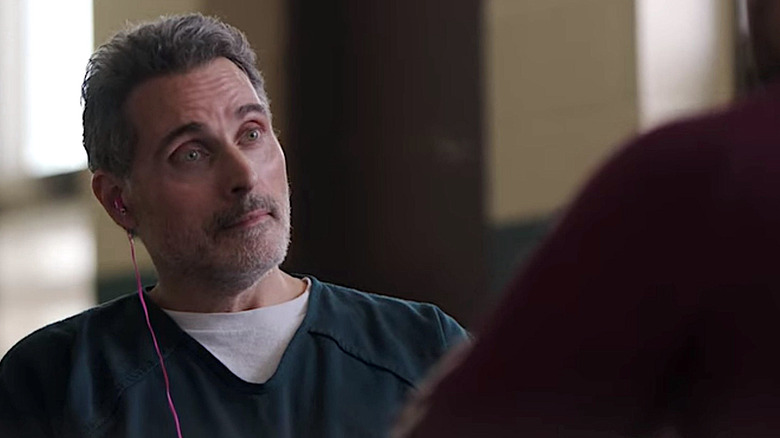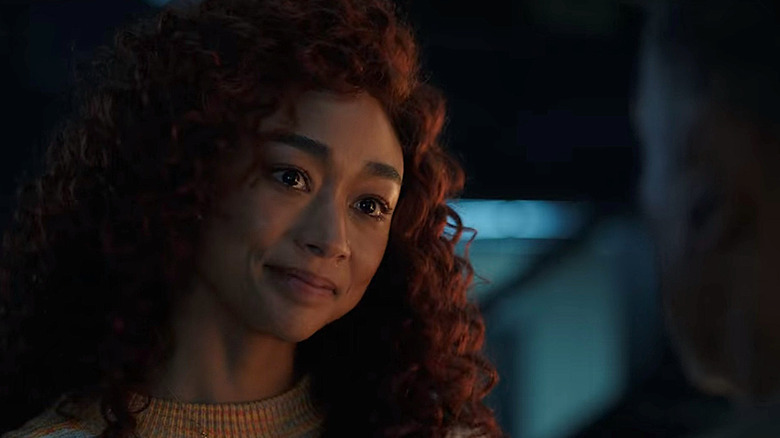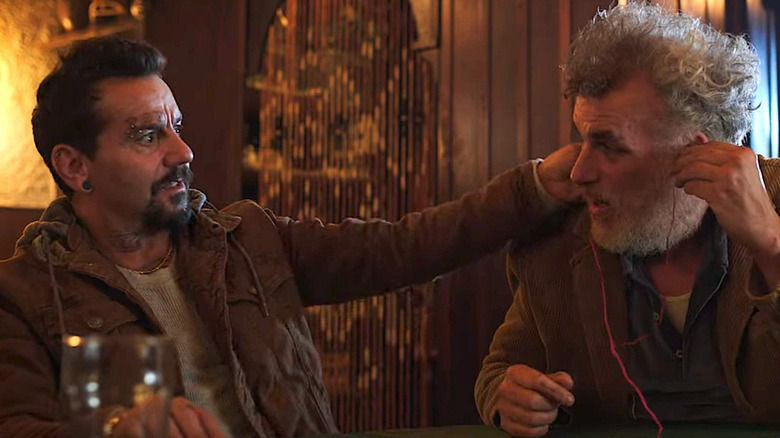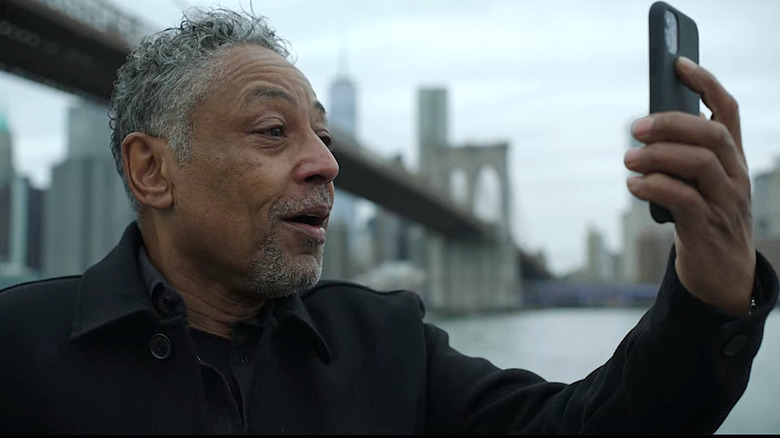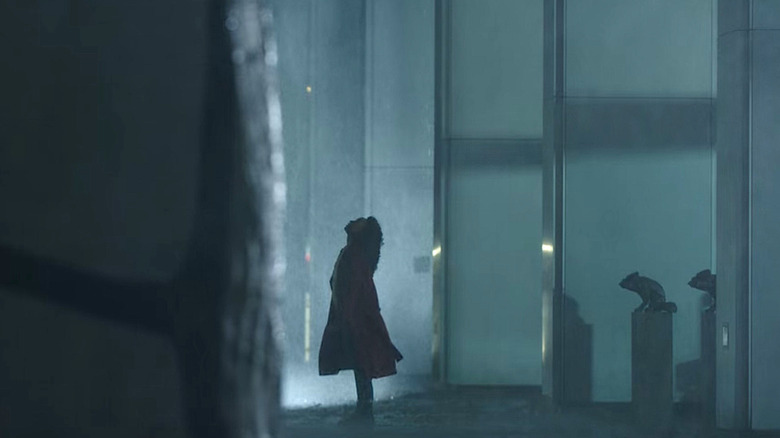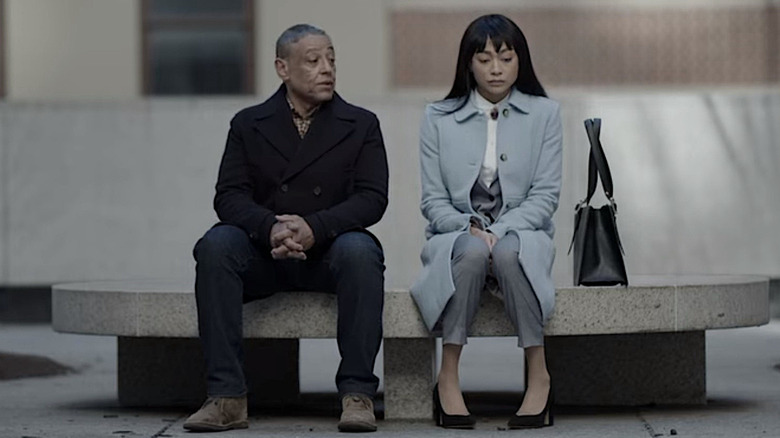The Ending Of Kaleidoscope Season 1 Explained
Dazzling heist drama "Kaleidoscope" is a non-linear, emotionally complex, and innovative thrill ride. The fact that all of the Netflix series' episodes can be viewed in any order (save "White," which should always be watched last) initially seems like a cool gimmick. But soon, it reveals itself to be an elegant feat of storytelling. The experimental timeline that fuels "Kaleidoscope" doesn't sacrifice the fun or drama inherent in the heist genre — in fact, it increases investment in the story's central heist and its mastermind, rather than scatters it. It certainly helps that said mastermind, Leo Pap, aka Ray Vernon, is played by Giancarlo Esposito, one of the modern day's most celebrated actors. The show's unique approach highlights his talents like never before.
"Kaleidoscope" is, without a doubt, unlike any other show on the air — and fans wouldn't want it any other way. But even the most diehard devotees might need a bit of help breaking down the ending of this ambitious saga. From heists-within-heists to shocking betrayals, we're here to untangle this series' many complex knots. This is the ending of "Kaleidoscope" Season 1, explained.
The professionals
"Kaleidoscope" isn't likely to be "one last job" for its makers, and it's certainly far from their first. Show creator Eric Garcia wrote the novel "Matchstick Men," which was adapted into the 2003 movie of the same name. That film was directed by Ridley Scott, who serves as an executive producer on "Kaleidoscope". Notably, "Matchstick Men," which stars Nicolas Cage and Alison Lohman as a father-daughter con artist duo, plays tricks on its characters and the audience, to entertaining and emotional effect. This is more than a little reminiscent of "Kaleidoscope."
Garcia and Scott aren't the only intriguing figures bringing relevant experience to bear on "Kaleidoscope." Leading man Ray Vernon is fantastically played by Giancarlo Esposito. He works hard to protect a super-secure underground lair, rather than breach one, as elegant criminal mastermind Gus Fring on "Better Call Saul" and "Breaking Bad." On the opposite end of the show's call sheet is Max Casella, who stars in the "Pink" episode as small-time crook and big-time podcast therapy fan Taco. While Casella's "Tulsa King" character Manny may just want to live an honest ranch life, in "Kaleidoscope," he's happy to steal every scene he's in.
Listen to the music
Every heist needs a crack team, a perfect plan, and a killer soundtrack. "Kaleidoscope" has all three. Composer Dominic Lewis' lively and emotional score makes the crew's actions seem all the more dangerous, devastating, and delightful. It also forms the backbone of each episode's splashy opening numbers, and features many heist-inspired motifs (recall the tapping, tumbling, and ticking on "Cut the Mustard"). This results in truly symphonic safecracking, and a wealth of narrative meaning.
The "Kaleidoscope" soundtrack is particularly stuffed with cheeky lyrical Easter eggs. O.V. Wright's "The Bottom Line" plays when Ray opens his store in "Violet" and has a moment of heist preparation in "Orange." Though these scenes are years apart, the lyrics yoke them together and question Ray's plans by intoning, "You can't build a dream on lies and schemes." "Violet" also sees Lily (Robinne Lee) cue up Bettye Swann's "You're Up to Your Same Old Tricks Again," foreshadowing Ray's return to a life of crime and her own death. Finally, Bob's (Jai Courtney) swan song on Folly Beach is an especially glorious bit of musical meaning. As Bob makes his drug-fueled, sleep-deprived, totally-misguided last stand for Judy's (Rosaline Elbay) love — and walks into a deadly ambush by the feds — "If You Don't Know Me By Now" by Harold Melvin & The Blue Notes plays loud and clear.
Stan Loomis
Stan Loomis (Peter Mark Kendall) is a smuggler who loves the finer things in life and lacks a taste for personal growth — or even basic heist hygiene. More than once, Stan's distractible, dreamy nature leads to ruin for the crew. Most notably, he leaves his hipster glasses at the scene of the crime and makes a getaway in a car with easily traceable vanity plates.
Uniquely, though he's one of the least violent members of the crew, Stan indirectly spills his share of blood. Carlos (Hemky Madera) takes out Stan's mother and wife, and Stan dodges the feds when they take down Bob. By the end of "Kaleidoscope," Stan has also butchered any chance he once had to learn from his mistakes. Still, he lives to try another day — and stuff his face with tacos de lengua when he realizes Judy has likely taken the money and run.
Ava and the feds
A bent lawyer who moonlights as a fence, Ava Mercer (Paz Vega) is Agent Nazan Abbasi's (Niousha Noor) white whale. In order to protect Ray after he escapes from prison, Ava notifies the FBI that Nazan is using drugs on the job. This costs Nazan custody of her kid, and kickstarts her quest for revenge against Ava.
Nazan's obsession with Ava and Ray comes to a fatal head in "Pink" and dead-ends in "White." While Ava's motives aren't always entirely clear outside of her fondness for Ray, her grandmother, and the high life, Nazan's obsession with tying Ava (and ultimately, Ray) to the Diamond Way heist and the SLS job is simple: The lady wants revenge.
Ultimately, Nazan gets a version of this, as Ava is killed in a shoot-out after a bitter fight for her life. But Nazan doesn't live long enough to enjoy it — or any more smooching with Agent Samuel Toby (Bubba Weiler.) As Roger (Rufus Sewell) warns Hannah (Tati Gabrielle) in "Yellow," the Triplets take Nazan down by sending a lackey to brush up against her in the street. She dies a few steps later. This is just another way "Kaleidoscope" drives home the idea that chasing white whales only leads to death by drowning.
Bob and Judy
Sometimes you don't just find love in a hopeless place — the love itself is the hopeless place. Bob and Judy Goodwin's story shows how hard it is to escape a toxic romance and a life of crime. Essentially, Bob is fire, Judy is gasoline, and together, they burn down any trust left among the crew on the night of the heist. This comes to a head when Bob attempts to steal the full seven billion for them and take out the rest of the team.
While Judy appears to end her relationship with Bob in "White" by seemingly killing him to save Stan, we see her heart still belongs to him in "Pink." Points to Bob for listening to a self-help podcast on his road to revenge, but it's too little, too late. "Kaleidoscope" knows old habits don't just die hard — they die twice. Bob meets an end that awaits so many fueled by jealousy — one he could have avoided by going to therapy before he's set on a one-way path to bleeding out on the beach.
RJ and Liz
Alas, poor RJ (Jordan Mendoza), we knew you — well, not very much at all. Though he's great with mechanics and music, the crew's getaway driver doesn't have much to do, aside from making the occasional funny comment and shooting Bob in the bum. Though Mendoza plays him with sweet, winning energy, RJ still loses big time.
Crime isn't in RJ's nature, but he fights to prove himself to Ray and the crew. One of the central questions "Kaleidoscope" asks regards whether anyone can really change, and if it's worth it. RJ sort of changes from good-ish dude to hardened criminal by drawing a gun on Bob. But he can't quite make the tough guy transition stick — especially since RJ's trying to protect Judy, who kills him to protect Bob. Ultimately, he's just too good for the heist game, and way too bad at playing it.
On a happier note, Hannah's sister Liz (Soojeong Son) survives the emotional ending of "Kaleidoscope" in "Pink" and gets away with Hannah's heist-within-a-heist in "White." Like RJ, we don't know much about Liz, but unlike RJ, we know she's comfortable enough with crime to know how to keep her nose clean. However, RJ might have gotten off easy if Liz traded her life of leisure for a life of helping Hannah manage the Triplets' wealth.
Roger
With cheekbones that good, Roger Salas has got to be bad. While most episodes portray Roger as the well-heeled and respected creator of the world's safest safe, we know the truth: Roger is the latest long con pulled by Ray Vernon's former partner in crime, Graham Davies. If Ray's story explores how poisonous a life fueled by revenge can be, Roger's is a cautionary tale confirming there's no rest for the wicked. Though Roger enjoys the high life, he's always looking over his shoulder, even before Leo and his crew arrive on the scene. How else would he have thought to employ Carlos?
Roger admits to Ray that he isn't sure he could've saved Lily. He tells Hannah that loyalty means nothing to him. He even puts out a hit on Ray. But there's something bittersweet in just how much he protests against connection, while also blatantly seeking it. He's also inclined to connect battles and keep what he's stolen. But as his wife leaves him and he loses his son to what may one day be a murder charge, it's easy to see his treasure for what it is: fools' gold.
Hannah
Hannah Kim is Ray Vernon's daughter and Leo Pap's greatest protégé. She's warm, intelligent, and inscrutable when it comes to where her allegiance lies — at least until "Pink," when she reveals to her father that she took the take and switched the bearer bonds with copy paper. Why does she do this?
Cynics will say Hannah plays her dad to save her own neck from the Triplets, but her heartfelt admission to Ray makes it clear that she pulls the con to save her Dad from himself. By switching the bonds out before the crew can make off with them, she protects the evil trio's fortune and buys back her Dad's safety — and also a super-sweet mansion to live in with her baby and Ava's dogs. Hannah breaks the family cycle of self-sabotage, bonds with her estranged dad, and seems to be the only member of the "Kaleidoscope" heist crew to come out on top.
It all seems peachy, until you consider the international bad guys who now run Hannah's life — and the fact that her dad is likely murdered by Roger Salas' kid. If these sobering realities don't take the sweeness out of that seaside mansion, we don't know what will.
The side criminals
Let's hear it for the side criminals of "Kaleidoscope." These guys aren't exactly gentlemen thieves like Ray, but they are horrifying, haughty, and hilarious. Plus, they all meet absolutely awful ends that illustrate a key "Kaleidoscope" theme: If you do crime long enough, you'll definitely take a fall.
Carlos is Roger Salas' right-hand man, ready to throw hands (and guns) whenever the need arises. Though this hitman picks off his fair share of lives, he meets his own bitter end in "Red." Then there's Andrew (Patch Darragh) a former employee of Roger's who is framed by Hannah and engages in his own crimes of extortion after Roger fires him. "Kaleidoscope" demonstrates that greed is definitely not good many times over, especially when cocky Andrew overplays his hand and gets a plastic bag to the head for his trouble.
Perhaps the most memorable side criminals of all are the therapy podcast-loving Taco and cardigan-rocking Samson (Craig Walker). This dynamic duo provides a brief but potent shot of belly laughter alongside their bloodshed during their brief time on screen. Taco also shows change is possible: His therapy-improved relationship inspires Bob to write Judy a heartfelt letter, expressing his desire to make healthy changes after he takes out Stan.
Ray
"Kaleidoscope" is about cycles, whether it's the turn of the screw, the tumble of locks, or the spin of the titular kaleidoscope. These characters circle the truth of themselves through each choice they make, then endure the full-circle consequences — and occasionally, the benefits . At the center of these overlapping cycles is Ray Vernon, alias Leo Pap. Cycles are nearly impossible to break, and Ray is the foremost symbol of this theme. Many episodes are framed by his attempts to express to Hannah why he's done what he's done, and why so much of it is motivated by his desire to change — or at least to redeem himself.
It's never been about the money for Ray; it's about revenge. He gets it, but at a grave cost. When the one silver lining of your perfect heist is that your daughter heisted it out from under you in order to save your life — well, that's a sign times are hard. Indeed, Ray loses a whole lot over the course of "Kaleidoscope": the bonds, his crew, Ava, and ultimately his own life. Yet he still wins. He may be driven to exact revenge on Roger for not saving Lily — a revenge he achieves by stashing the club jewels in Roger's private vault — but his true bounty is Hannah's forgiveness and acceptance. This is in spite of his unbroken cycle of crime, which is the ultimate reason Lily dies.
The heists
"No one can pinpoint the exact moment it all fell apart," Ray says, as they crew sails away from Manhattan and into a bleak future in "Red." The heist goes off perfectly, but afterwards, everything goes sideways. Indeed, "Kaleidoscope" gives its crew plenty of opportunities to suffer and shine. Seeing our master criminals (and junior fools) at their best and worst creates an intriguing energy, which makes "Kaleidoscope" stand out.
As creator Eric Garcia told The New York Post, he drew influence from many classic movies, including "Pulp Fiction" and "Rififi." "White," like "Rififi," showcases a largely nonverbal and very intricate heist sequence. The first line spoken comes when Stan says, "Well that was easy," after a number of complex steps. "Kaleidoscope" also delivers its own contributions to the heist hall of fame, including Judy's press-on nail/sim card hand-off and the sweetly comic distraction of dosing the prison mess with magic mushrooms. Best of all is the moment when Hannah heists her dad in a neat (and well intentioned) double cross he doesn't anticipate. The show doesn't indicate this until the very last moment, which turns feelings of deception into the pure delight of seeing an excellent magic trick pulled off.
The heist within the heist
"Kaleidoscope" is a fun and stylish crime show, but it's also a show about big feelings. Obsession, revenge, trust, and family loyalty fuel the series and pack it to the brim with emotional heat. The biggest weapon in its arsenal is a double-barreled shotgun of revenge and regret. Because of the, yes, kaleidoscopic nature of the show's storytelling, we get to see its many characters — especially Ray Vernon — shift throughout time. They change dramatically, creating a vivid portrait of their motivations.
Maintaining an entertainment factor and emotional resonance at the same time is key to good storytelling, but it's also hard to pull off. It's an even neater trick to balance these two forces while creating a show that can, according to Yahoo!, be watched more than 5,000 different ways. In a sense, pulling this off is pulling off a magnificent heist while telling a story about heists. It's a testament to the cast and crew that the criminally compelling "Kaleidoscope" manages to accomplish this. It's also promising for the future of popcorn entertainment. If a big, splashy, heist-centric TV show can deftly tackle destructive cycles, unspeakable trauma, and the difficult healing process while also giving us heist sequences hinging on hurricanes, there may be hope for streaming media yet.
